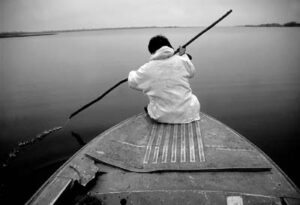Across a frozen lake 10 kilometers east of the small Siberian village of Kazym, Sasha and his son, Ephiam, drag a sled loaded with a tangle of fishing net and rope. Two of Sasha’s friends soon follow with long poles freshly cut from the nearby forest. They also trek to a spot a couple of hundred meters from shore. No matter that the lake has iced over solid, these men are going fishing.
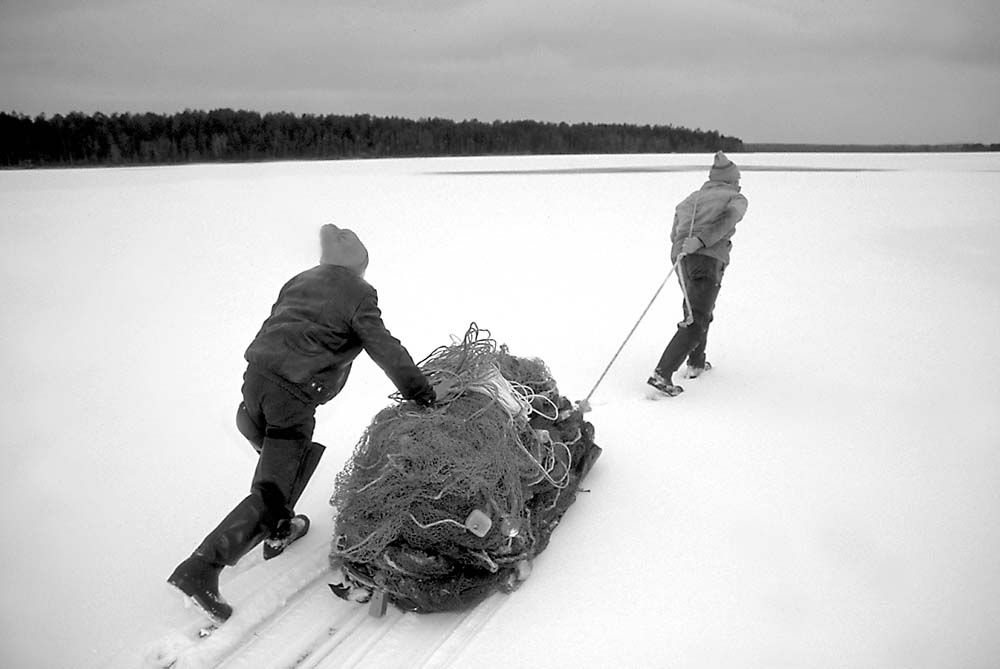
The process of setting a fishing net and then pulling it in is easy enough when the lake isn’t frozen, but doing so under 30 centimeters of ice is a different matter. With axes in hand the men chop a series of small holes, some three dozen in all, in the shape of a rectangle several dozen meters across. At opposite ends of the rectangle larger access holes, each of them one by two meters in size, are also cut. Into one of these larger openings, poles long enough to reach from one hole to the next are slipped under the ice. Going in opposite directions each pole has a rope tied to the end which, in turn, is tied to the ends of the net. With the help of grappling hooks the men maneuver the poles from opening to opening beneath the ice, dragging the lead rope and, consequently, the net along. Despite temperatures of minus 20 degrees Celsius, bare hands often are immersed into the water to help in the process. After the net is spread out beneath the ice the men gather at the access hole opposite of where the net went in and together they slowly retrieve the net and their catch from the dark, frigid water.
Fishing, be it beneath the thick ice that skims the waterways of northern Siberia for eight months of the year, or in the warmer days of summer and early fall, has been the primary means in which the Khanty have made a living for as long as they have been in existence. And it is still so today. It might be said that the economics of fishing is the primary reason why the Khanty still fish; that in this land of countless rivers and lakes it is the most viable means of supplementing a meager income. But given the fervor with which they attack this vocation, it is clear that fishing, along with other means of utilizing local natural resources, is still a part of who the Khanty are culturally.
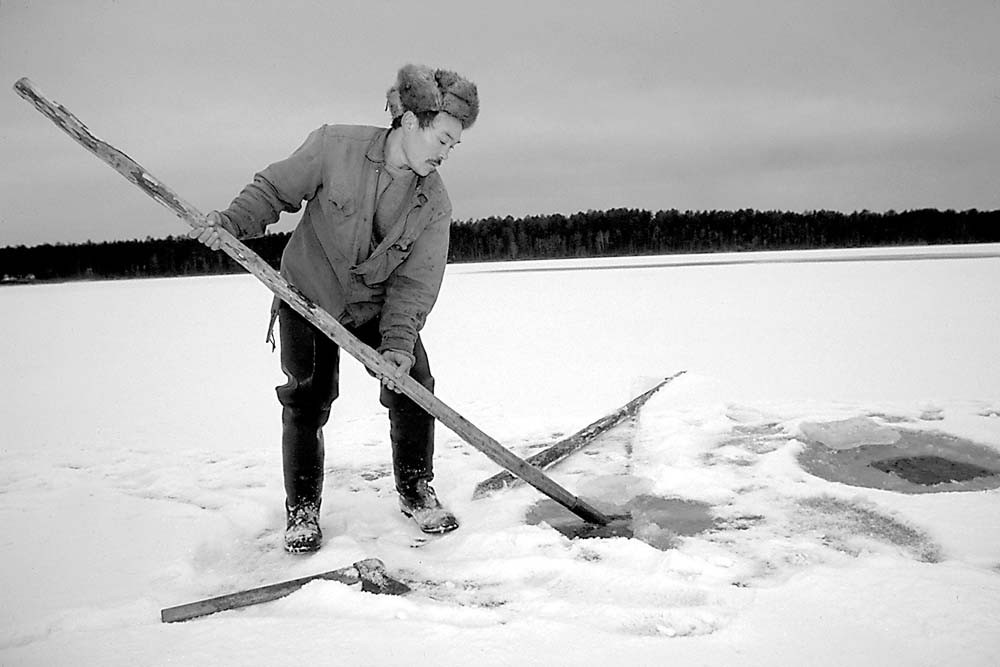

Historically speaking, the Khanty have inhabited the middle and lower Ob River Basin of northwestern Siberia for more than 1,000 years. In this shingle-flat land of sinuous rivers, sizable lakes, marshes and bogs, the Khanty have become quite adept at surviving and even thriving in an unforgiving environment. Centered around the most promising bounty of the region, fishing has always been their primary means of survival. For some Khanty, fish still make up 70% of their diet. But the hunting of moose, rabbits, squirrels, water fowl and the like also has played an important role in their survival. The trapping of such fur-bearing mammals as sable and fox have provided important sources of clothing. The harvesting of pine nuts, a multitude of different berries and mushrooms has supplemented diets greatly. And many Khanty living in the sub-Arctic taiga lands that stretch north of the Ob River have taken up reindeer herding, a vocation they acquired from their Nenets neighbors in the 17th century.

Traditionally, the Khanty lived in isolated homesteads based on family groups. Often, an entire river basin belonged to a single extended family, the assignment of which was believed to have been divined by the gods themselves. This broad division of territory ensured that each group had suitable fishing and hunting grounds. Beginning with the arrival of Cossack traders in the 15th century, however, this settlement pattern began to change as some Khanty relocated to small villages located near trading posts. With the advent of the Soviet empire, many more were moved into area villages.
In the 1930’s, Kazym was established by the government as a “cultural base”. In theory, cultural bases were meant to entice the Khanty into village life with the benefits of schools, hospitals, stores and other communal conveniences. This effort to collectivize native peoples into manageable communities did see a great many Khanty abandoning their forest homes. Still others were relocated forcibly during the Stalin years. Additionally, compulsory attendance in boarding schools located in villages such as Kazym meant that Khanty children were removed from traditional homes and, for many years, were forbidden to speak their native tongue or follow their cultural beliefs.

Given all of the government’s efforts to Sovietize the Khanty, it would seem that their traditional adherence to life in the forest effectively would have been erased. Indeed, most Khanty who live in Kazym today earn wages or draw pensions. They buy provisions from small village stores or shop in Beloyarskii, a small city some 40 kilometers away. Some own automobiles and many own televisions. They take full advantage of Kazym’s new hospital and their children attend school. Nevertheless, regardless of their full participation in contemporary Russian life, the draw of the surrounding taiga lands is still strong for many.
During much of the year, Yakov Tarlin’s small motorboat sits idle among Kazym’s armada of aging water craft that line the high water mark of the Amnya River. By early June, however, after the snow has melted and the land has dispensed with the excess water, Tarlin extracts an outboard motor, spare oars, hip waders, and a fishing net from his storage shed. In a short time, his boat is contributing to the collective drone of two-stroke engines that can be heard up and down the waterway throughout the long days and into the glimmering white nights.

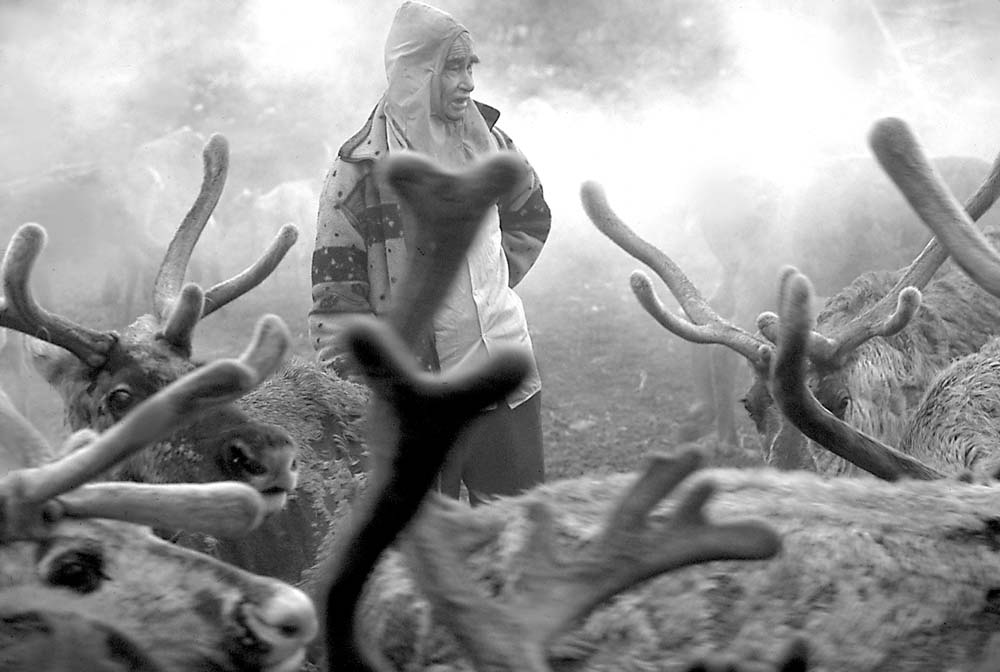
With friends who will share in both performing the work and enjoying the day’s catch, Tarlin heads downstream to where the Amnya empties into the larger Kazym River. A right turn takes them upstream a few bends to a broad sandy beach on starboard side. On shore the long net is carefully piled on the bow of the boat. Yakov then rows out into the lazy current a ways before angling back to shore. With the help of a friend, the net is dropped into the water forming a broad arc that bulges halfway across the river. Once back on shore the net is then pulled in and, as the final few meters of net emerge from the water, a dozen or so fish flop helplessly in the tangle of string. After the process is repeated for most of the day, Tarlin and his friends motor back to Kazym with a burlap sack full of fish.
In summer, the taiga forests of northwestern Siberia play host to a scourge of Kafkaesque proportions. It begins in late June as temperatures remain above freezing and lasts into early August. Swarms of mosquitoes appear and attack anything that moves. So bad are the bugs that it is said a person would die within three hours if not protected. For reindeer breeders like Alexei Moldanov the arrival of the mosquitoes is not simply an inconvenience; it poses a threat to his livelihood.
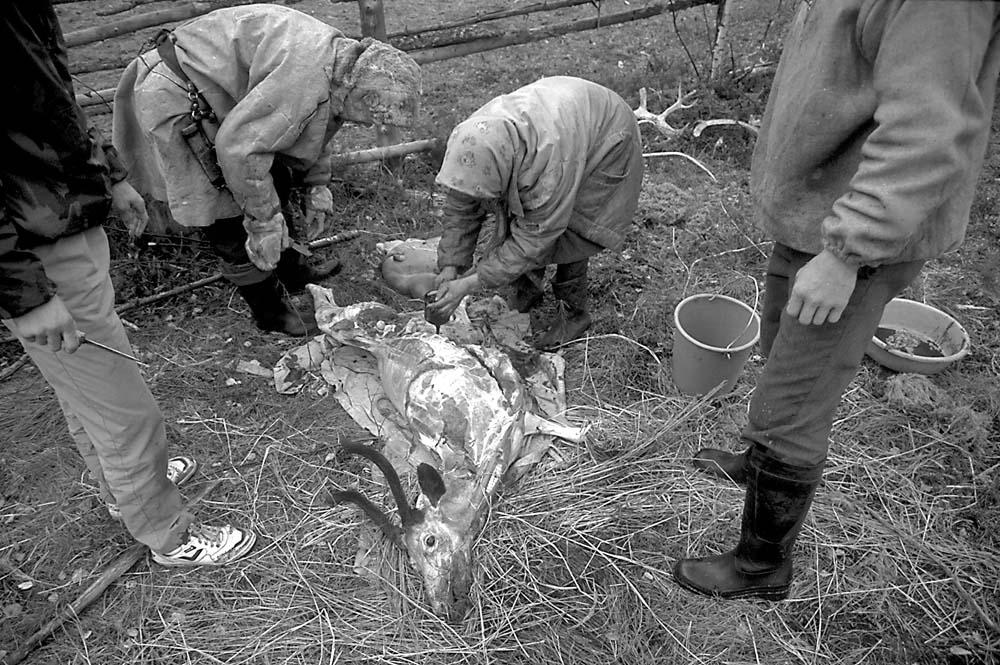
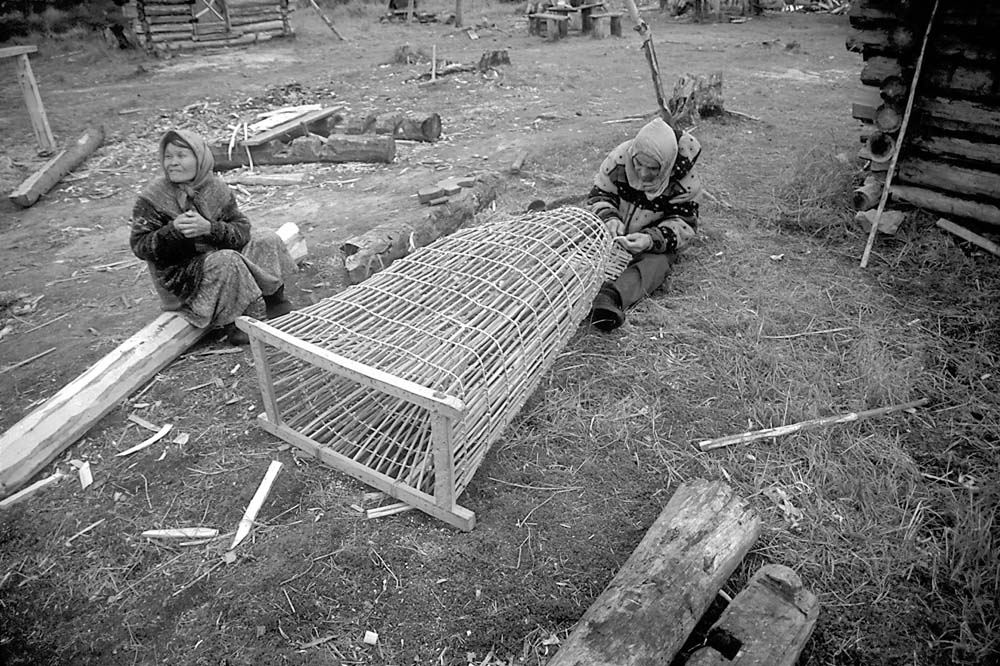

Although one of the best equipped animals to handle frigid Siberian winters, reindeer are not as prepared to battle these voracious, blood- sucking insects, especially since they arrive at a time of the year when the deer are between coats and their bodies are not protected sufficiently. To assist the deer, Alexei and his wife, Ducia, must spend several hours each day digging up large squares of peat, cutting green logs, and stacking evergreen boughs – the ingredients for inordinately smoky fires. When the mosquitoes swarm, the deer forsake any natural aversion to fire they may have to stand in the dense smoke. Reflecting the pecking order of the herd, alpha males claim the thickest billows of smoke, sometimes disappearing from sight. The rest of the animals crowd in downwind as best they can. This process is effective in combating the mosquitoes, but so too is a good stiff breeze. When the wind does pick up, the deer will trail off to forage but when the air grows still again the herd comes running back to the corral expecting smoke. In years when the mosquitoes are especially bad and breezes especially few, the deer may not eat enough and some weaker animals will be lost.
By mid-August, the swarms of mosquitoes are replaced mostly by less persistent insects and the deer’s coats begin to thicken. This means that the Moldanovs can turn their attention to other aspects of making a living in their remote forest home, such as fishing. By impeding the natural migrations of fish in nearby streams and small rivers with barriers erected from a row of vertically placed poles, they divert the fish in large, conical traps fashioned from wooden battens and twine. The traps are pulled daily and the fish are taken back home to be dried for later use. While much of their take is for human consumption and scraps are fed to the dogs, some of it is put away for the reindeer. According to the Moldanovs, it is the promise of dried fish treats that keep the deer close to home in the winter months.
With fishing in full swing, September is also the best month for harvesting another bounty of the land, berries. Up until the first snows permanently blanket the land for the season, the women of Kazym troop into nearby timberlands with handmade birch bark baskets strapped to their backs. They head out in pairs or in small groups, often with children tagging along to help. The labor can be tedious but the end result includes a winter’s supply of vitamin-rich berry preserves and juices.
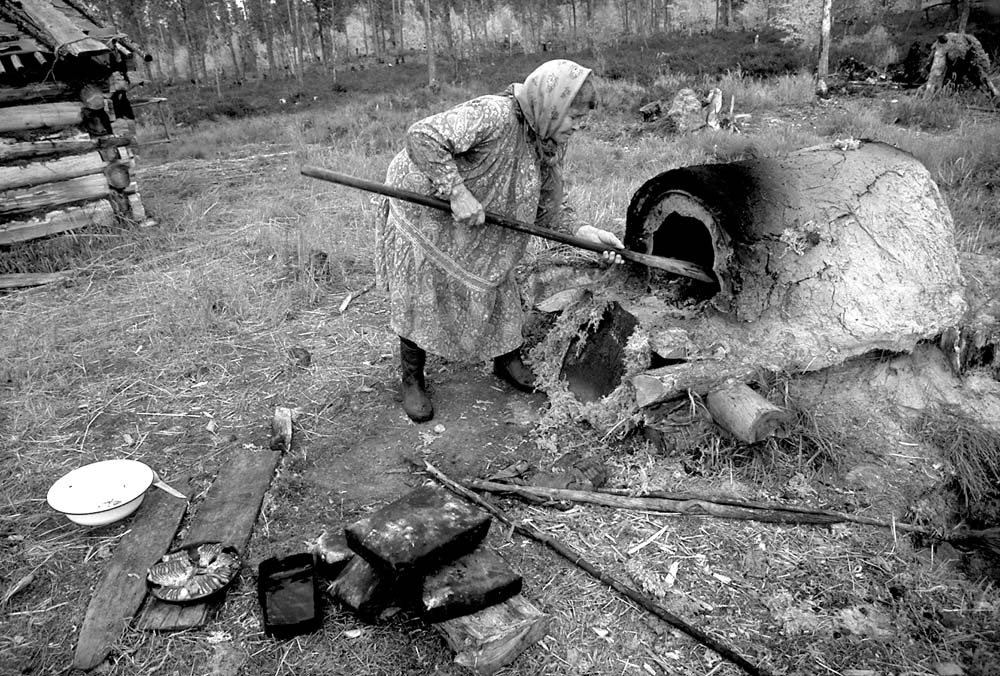
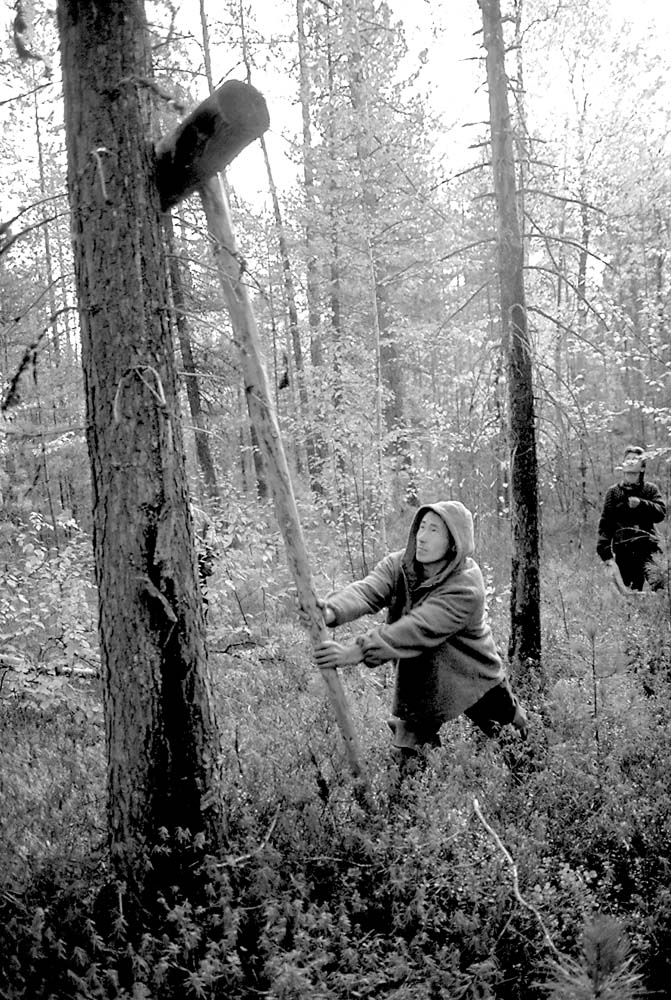
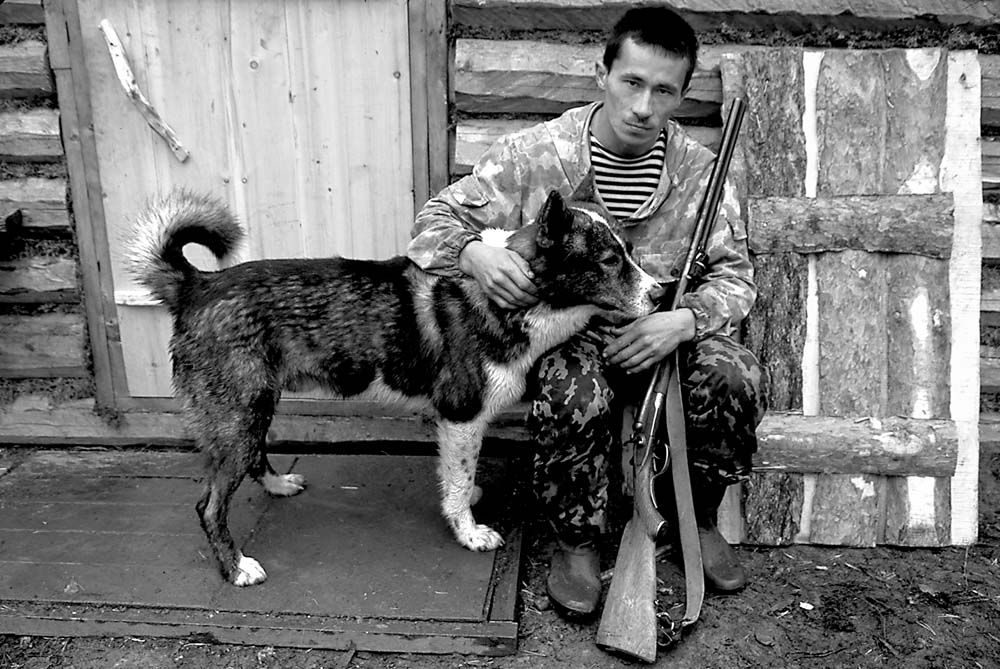
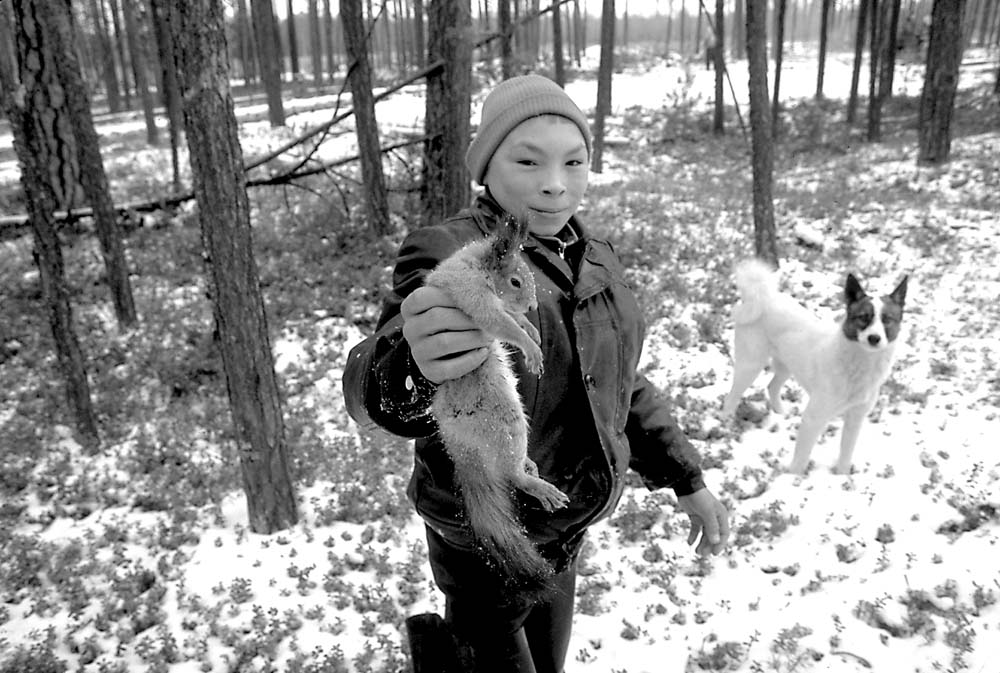
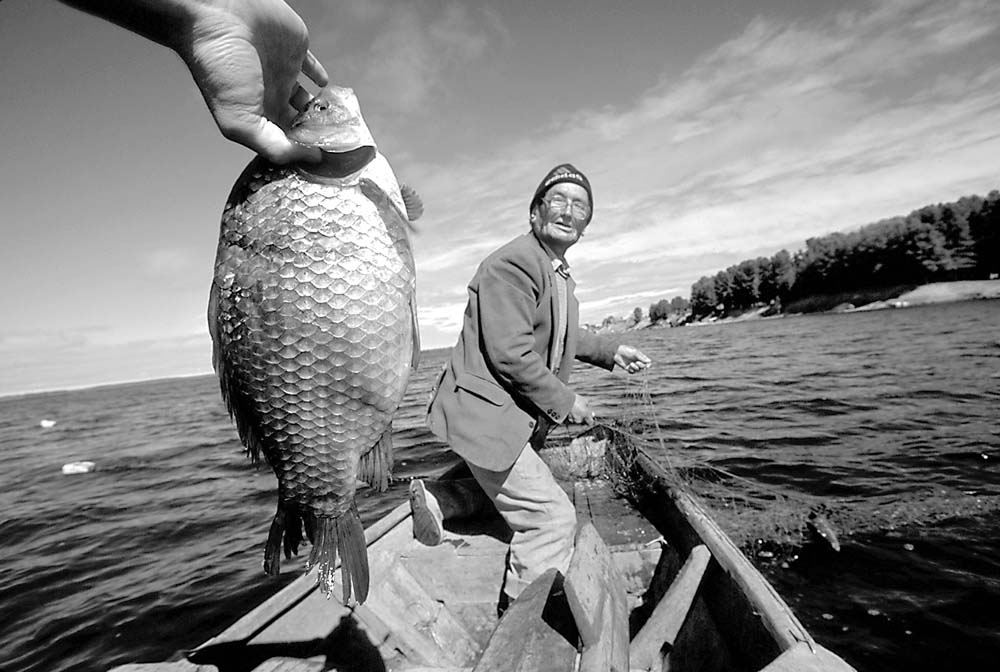

Rima Potpot, along with her children, Katea and Alek, and a Zyranian friend, Irina, form one such berry picking expedition. They trek five kilometers west from Kazym to an expansive stand of timber. They search until early afternoon but find only thin patches of klukva, a red fruit about the size of a blueberry which grows on low ground cover in open stands of timber. Dismissing their lack of success, they instead stop for dinner. A fire is started. Fish is boiled, tins of canned meat are opened, bread is sliced, tea is brewed and a bag of hard candies is opened. The meal is a full and merry one, as there is plenty of time for joking and gossiping, and the enjoyment of friendship. It reveals that perhaps these women are here for more than one reason. Whereas picking berries — fishing, collecting nuts, hunting, and working reindeer — should result in the putting up of food, it is also a joy for these people.
After dinner, Rima’s group continues on and in short time they happen upon a stretch of forest thick with klukva. The four of them drift about the well spaced tree trunks for more than two hours, bent to the task of picking the plump, juicy berries. Although occasional handfuls of berries are popped into their mouths, they soon fill their birch bark baskets and then troop back to Kazym. That they would find this productive patch of berries was not in question for it is unthinkable that the forest would not produce its bounty in this or any other September.
©2001 Scott S. Warren
Scott S. Warren, a freelance photographer from Durango, Colorado, is examining Khanty life in Siberia.



